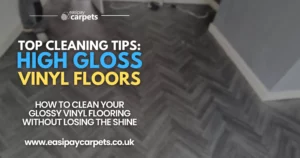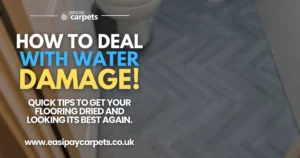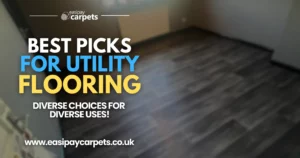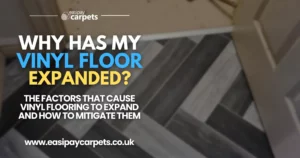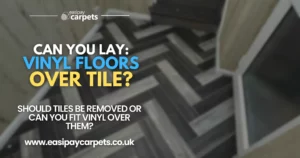
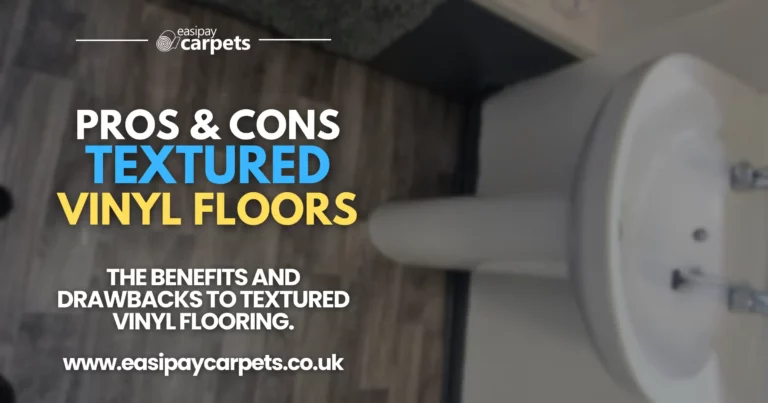
Textured Vinyl Flooring - The Benefits and Drawbacks
Textured vinyl flooring is a popular choice for homeowners looking for a durable, stylish, and versatile flooring option. It combines the benefits of traditional vinyl with added texture, which can enhance both the aesthetic appeal and functionality of the flooring. However, like any flooring choice, it comes with its own set of advantages and disadvantages. In this guide, we’ll explore the pros and cons of textured vinyl flooring and highlight the areas where it comes in especially handy, helping you decide if it’s the right fit for your home.
What Is Textured Vinyl Flooring?
Textured vinyl flooring is a type of vinyl that has a surface pattern or texture that mimics the look and feel of natural materials like wood, stone, or tile. This texture can range from subtle embossing to more pronounced patterns that provide a realistic, tactile surface. Textured vinyl can come in various formats, including planks, tiles, and sheets, making it a versatile option for different spaces in your home.
Pros of Textured Vinyl Flooring
Textured vinyl flooring offers numerous benefits that make it an appealing choice for various applications. Here are some of the key advantages:
1. Enhanced Slip Resistance
- Benefit: One of the main advantages of textured vinyl flooring is its improved slip resistance compared to smooth vinyl options. The texture provides extra grip underfoot, reducing the risk of slips and falls, especially in areas prone to moisture.
- Where It’s Handy: This makes textured vinyl ideal for kitchens, bathrooms, laundry rooms, and entryways where spills and wet conditions are common.
2. Realistic Appearance
- Benefit: Textured vinyl is designed to mimic the look and feel of natural materials like hardwood, stone, and tile, making it a stylish choice that can elevate the appearance of any room. The texture adds depth and realism, making it hard to distinguish from the real thing.
- Where It’s Handy: It’s perfect for living rooms, bedrooms, and dining areas where you want the luxurious look of natural materials without the high maintenance and cost.
3. Durability and Low Maintenance
- Benefit: Textured vinyl is highly durable and resistant to scratches, dents, and stains, making it suitable for high-traffic areas. It’s also easy to clean and maintain, requiring only regular sweeping and occasional mopping to keep it looking fresh.
- Where It’s Handy: Ideal for busy households, pet owners, and families with children, textured vinyl can withstand daily wear and tear with minimal upkeep.
4. Comfort Underfoot
- Benefit: Textured vinyl flooring often feels softer and warmer underfoot compared to traditional tiles or hardwood. This added comfort makes it a pleasant option for areas where you spend a lot of time standing, such as the kitchen.
- Where It’s Handy: Kitchens, playrooms, and home offices are great spaces for textured vinyl, offering a comfortable surface that’s easy on the feet.
5. Water Resistance
- Benefit: Like other vinyl flooring, textured vinyl is highly water-resistant, making it a practical choice for rooms with high humidity or exposure to water.
- Where It’s Handy: Bathrooms, laundry rooms, and basements benefit from textured vinyl’s ability to resist water damage and maintain its appearance over time.
6. Easy Installation
- Benefit: Textured vinyl is available in easy-to-install formats like click-lock planks, peel-and-stick tiles, and sheet vinyl, allowing for DIY-friendly installation. It can often be installed over existing floors, saving time and money on preparation.
- Where It’s Handy: Great for DIY projects, rental properties, or quick renovations where time and budget are considerations.
Cons of Textured Vinyl Flooring
While textured vinyl flooring has many advantages, there are some drawbacks to consider:
1. Can Be Harder to Clean
- Drawback: The textured surface of the flooring, while beneficial for slip resistance, can also trap dirt and grime more easily than smooth surfaces. This can make cleaning a bit more challenging, especially in high-traffic areas.
- Consideration: Regular sweeping and mopping can help manage this, but textured vinyl may require more attention to keep it looking pristine.
2. Susceptible to Scratches and Scuffs
- Drawback: Although durable, textured vinyl can still be susceptible to scratches and scuffs, especially from heavy furniture or sharp objects. The texture can sometimes hide minor imperfections, but deep scratches may be more visible.
- Consideration: Using furniture pads, area rugs, and avoiding dragging heavy items across the floor can help mitigate this issue.
3. Limited Repair Options
- Drawback: If textured vinyl flooring becomes damaged, repairing it can be difficult. Unlike hardwood, which can be sanded and refinished, or tile, which can be re-grouted, vinyl typically needs to be replaced if it suffers significant damage.
- Consideration: Keeping extra planks or tiles on hand can help with replacements, but repairs may still be more noticeable compared to other flooring types.
4. Not Biodegradable
- Drawback: Vinyl flooring, including textured vinyl, is not biodegradable and has a relatively high environmental impact. Disposal can be an issue, as it often ends up in landfills.
- Consideration: Consider options like recycling or donating usable flooring, and look for products made from recycled materials to lessen the environmental impact.
5. Temperature Sensitivity
- Drawback: Textured vinyl flooring can expand and contract with temperature changes, which may lead to gaps or buckling if not installed correctly.
- Consideration: Proper acclimation before installation and maintaining stable indoor temperatures can help mitigate this issue.
Where Textured Vinyl Flooring Comes in Handy
Textured vinyl flooring’s combination of style, durability, and functionality makes it suitable for a variety of spaces. Here’s where it shines:
- Bathrooms: Its water resistance and slip-resistant texture make it ideal for bathrooms, reducing the risk of slips while withstanding moisture.
- Kitchens: The comfort underfoot and ease of cleaning make textured vinyl a great choice for kitchens, where spills and heavy foot traffic are common.
- Laundry Rooms: Textured vinyl can handle the humidity and occasional splashes of water found in laundry rooms, providing a durable and attractive surface.
- Basements: Its water resistance and ability to mimic high-end materials without the cost make textured vinyl a practical and appealing option for basements.
- Entryways and Mudrooms: The texture helps reduce slips and hides dirt well, making it perfect for high-traffic areas where people are entering with wet or muddy shoes.
Conclusion
Textured vinyl flooring is a versatile and practical choice for many areas of the home, offering enhanced slip resistance, durability, and a realistic appearance that mimics natural materials. While there are some drawbacks, such as potential cleaning challenges and repair limitations, the benefits often outweigh these concerns, especially in areas where safety and water resistance are priorities. By understanding the pros and cons of textured vinyl flooring and where it comes in handy, you can make an informed decision that best suits your needs and lifestyle.
Easipay Carpets can help you get brand new flooring without the high up-front cost – by simply letting you spread the cost of the flooring over time instead. There’s no interest on our plans so you aren’t spending a penny more than you would buying it outright and we include underlay, door trims, carpet grippers and laminate beading for free. Prices start from just £10 per week!
It starts with a free home appointment and quote, to get booked in at a time that suits you, tap the “Get Started” button below and fill out the contact form!
Still Got Questions? Here's 10 FAQs!
Textured vinyl offers enhanced slip resistance, a realistic appearance, durability, comfort underfoot, water resistance, and easy installation.
Yes, textured vinyl can be harder to clean, susceptible to scratches, difficult to repair, not biodegradable, and sensitive to temperature changes.
Yes, textured vinyl is ideal for bathrooms due to its slip resistance and water-resistant properties.
Regular sweeping and mopping are recommended, but textured surfaces may require more thorough cleaning to remove dirt trapped in the grooves.
Yes, textured vinyl can often be installed over existing floors as long as the surface is clean, dry, and level.
While durable, textured vinyl can still scratch from heavy furniture or sharp objects. Using pads and avoiding dragging items can help prevent damage.
Textured vinyl is not biodegradable and can have a high environmental impact. Choosing recycled options or recycling used vinyl can help reduce its impact.
Textured vinyl offers better slip resistance and a more realistic look, while smooth vinyl is easier to clean but may be more slippery.
Yes, textured vinyl is designed to handle heavy traffic and is a great option for busy households, especially in entryways and kitchens.
Proper acclimation before installation and maintaining a stable indoor temperature can help prevent expansion and contraction issues.
